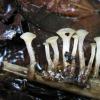
09-12-2025 12:06
 Andgelo Mombert
Andgelo Mombert
Bonjour,Je recherche l'article concernant Hypobryo

07-12-2025 16:07
Arnold BüschlenHallo, ich habe in einer Moos-Aufsammlung (epiphy

08-12-2025 21:04
Mark Stevens"Hello everyone,I'm relatively new to microscopy (

08-12-2025 18:59
 Lothar Krieglsteiner
Lothar Krieglsteiner
.. found by a seminar-participant, I do not know t

08-12-2025 17:37
 Lothar Krieglsteiner
Lothar Krieglsteiner
20.6.25, on branch of Abies infected and thickened

16-03-2014 22:00
Hello,I found this species a few months ago but ha

08-12-2025 13:39
Thomas Læssøehttps://svampe.databasen.org/observations/10572899
??Dear everyone.
This discomycete, frequently found in Japan, seems to be identical to Cudoniella clavus in macroscopic, microscopic, and ecological characters.
According to Dennis, etc., ascus pore of C. clavus is non-amyloid, but this ascus pore turns blue by IKI, more clearly with KOH pre-treatment. (I have no microphoto)
Is it true C. clavus?
Masanori Kutsuna

In Huhtinen 1985: 511 (mycoflora Poste-de-la-Baleine?) the reaction is clearly blue after KOH. Also In my collections I saw repeatedly a distinct blue reaction in IKI (Hymenoscyphus-type).
However, at least in one (HB 1000, from Black Forest) ?I noted IKI-. This explains why authors like Dennis, Breitenbach & Kränzlin or Gamundi 1998: 114? likewise found inamyloid asci.
Zotto?
Thank you for the answer.
Let me ask you a question.
If so, what is the difference between Hymenoscyhus and Cudoniella?
Regards,
Masanori Kutsuna

Zotto
Regards,
Kutsuna

